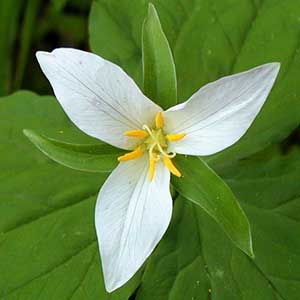Trillium ovatum
Trillium gracile
Pacific trillium, trillium, western trillium, western wake-robin, western white trillium, white or western trillium, white trillium
graceful trillium, Sabine River wakerobin, slender trillium
semierect to horizontal, short, stout, praemorse.
horizontal, brownish, thick, short, praemorse, not brittle.
1–2, round, 2–5 dm, ± slender, glabrous.
1–3, round in cross section, 1.6–3.5 dm, slender, glabrous.
sessile, subsessile, or short-petiolate;
blade medium green, sometimes blotched and mottled, main veins prominent, ovate-rhombic, 7–12 × 5–20 cm, continuing to expand during anthesis, base rounded, apex acuminate.
held well above ground, sessile;
blade mottled with darker green blotches, mottling becoming obscure with age, elliptic-ovate to obovate, 6–8.5 × 2.6–4 cm, base rounded, apex obtuse or rounded, rarely acute.
erect or nodding, odorless;
sepals spreading to horizontal, green, lanceolate to oblong-lanceolate, 15–50 × 6–20 mm, margins entire, apex acute;
petals erect-ascending, usually wide-spreading from base, exposing entire pistil, white or with pink or blush markings, lacking V-shaped markings, fading to rosy pink, purple, or dark red, veins not deeply engraved, ± linear to widely obovate, 1.5–7 ×1–4 cm, widest at or above middle, thin-textured, margins flat to undulate, apex acuminate;
stamens prominent, slightly recurved-spreading to straight, 10–18 mm;
filaments white, shorter than anthers, slender;
anthers yellow, 4–16 mm, slender, dehiscence latrorse-introrse;
ovary green or white, ovoid, 6-angled, 5–12 mm, attachment ± 3/4 ovary width;
stigmas recurved, barely connate basally, greenish white or white, linear, not lobed adaxially, 6–10 mm, uniformly thin;
pedicel erect to leaning, 2–6 cm.
odor musty or funguslike;
sepals displayed above bracts, bases at right angle to scape axis, widely spreading with recurved tips, dark purple on adaxial surface, lanceolate to oblong, 20–25 × 4–5 mm, margins entire, apex obtuse;
petals long-lasting, erect, weakly connivent, at least partially obscuring stamens, dark purple or maroon, rarely yellow, not spirally twisted, linear-elliptic to oblanceolate, 2–4 × 0.3–0.8 cm, ± thick-textured, margins entire, flat, apex acute;
stamens erect, 12–16.5 mm;
filaments purple, 2–3 mm, slender;
anthers erect, straight, purple to yellow, 10–15 mm, slender, dehiscence introrse;
connectives straight, extending 0.1–1 mm beyond anther sacs;
ovary purple, ovoid, 3-angled, 4–11 mm;
stigmas erect, spreading-recurved, distinct, purple to whitish, sessile, subulate, 2–4 mm, fleshy, thickened basally.
baccate, green or white, ± odorless, broadly ovoid, obscurely winged, 1.2–2.8 × 0.7–1.9 cm, pulpy-moist.
dark greenish purple, fragrance not reported, ovoid, swollen enough to conceal its 3-angled nature, 1 cm, pulpy, moist.
= 10.
Trillium ovatum
Trillium gracile
Varieties 2 (2 in the flora).
(Discussion copyrighted by Flora of North America; reprinted with permission.)
1. Bracts sessile; petals lanceolate to obovate, 1.5–7 × 1–4 cm | var. ovatum |
1. Bracts distinctly short-petiolate; petals linear to linear-lanceolate, 0.5–2.4 × 0.2–0.6 cm | var. oettingeri |
- Local floras:
BC,
CA,
OR,
WA
- Local Web sites:
CalFlora,
CalPhotos,
Flora NW,
PNW Herbaria,
Turner Photog.
WildflowerSearch
iNaturalist (observations)
USDA Plants Database
- LBJ Wildflower Center
- SEINet
- Plants of the World Online
- Encyclopedia of Life
- Wikipedia
- Google Image Search


